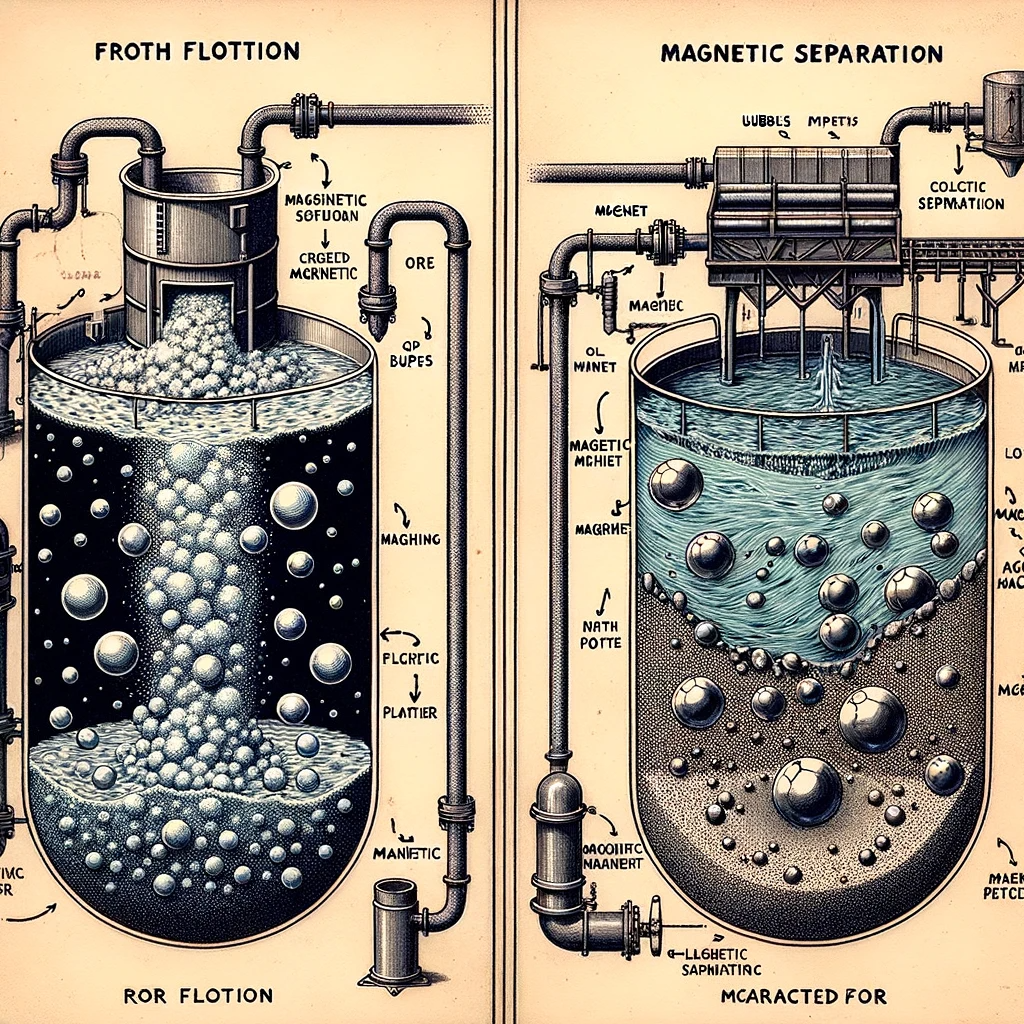2 Most FAQ’s of Principles of Metallurgy Chapter in Class 10th Physical Science (TS/AP)
8 Marks
LAQ-1 : Draw the diagram showing (i) Froth flotation (ii) Magnetic separation.

LAQ-2 : Write the precautions to be taken in the experiment to show air and water are essential for rusting iron articles and also write the experimental procedure.
For Backbenchers 😎
Okay, imagine you want to understand why iron things like nails get all rusty when they’re exposed to air and water. This experiment helps you figure that out, but you need to do it carefully.
Precautions:
- Make sure the nails you use are clean and don’t have any rust or dirt on them.
- Put the nails completely underwater so they all rust in the same way.
- Use special water called distilled water because it doesn’t have much stuff in it. You use it in one of the test tubes to create a space without oxygen (the stuff in the air).
What You Need:
- You’ll use 3 test tubes.
- You’ll need some iron nails.
- Also, get some corks, anhydrous calcium chloride (a chemical that sucks up moisture), regular water, and oil.
Steps:
- Label the test tubes as A, B, and C.
- Put 2-3 clean iron nails in each tube.
- In Test Tube A, just put regular water.
- In Test Tube B, pour boiled distilled water and then add some oil on top to stop air from getting in.
- In Test Tube C, add that special calcium chloride stuff to soak up any moisture in the air.
- Seal the test tubes up and leave them alone for a few days.
What Happens:
- After a while, you’ll see that the nails in Test Tube A get all rusty because they had both air and water.
- In Test Tube B, the nails won’t rust much because they had water but not much air.
- And in Test Tube C, the nails won’t rust either because they didn’t have much moisture in the air.
Summary:
This experiment teaches us why iron rusts. By being careful and following the steps, you can see that air and water are both necessary for rust to happen. It’s important for learning chemistry and understanding how to prevent things from rusting in the real world.
మన తెలుగులో
సరే, గోర్లు వంటి ఇనుప వస్తువులు గాలి మరియు నీటికి గురైనప్పుడు తుప్పు పట్టడం ఎందుకు అని మీరు అర్థం చేసుకోవాలని అనుకోండి. ఈ ప్రయోగం మీరు దానిని గుర్తించడంలో సహాయపడుతుంది, కానీ మీరు దీన్ని జాగ్రత్తగా చేయాలి.
ముందుజాగ్రత్తలు:
- మీరు ఉపయోగించే గోర్లు శుభ్రంగా ఉన్నాయని మరియు వాటిపై ఎటువంటి తుప్పు లేదా ధూళి లేకుండా చూసుకోండి.
- గోళ్లను పూర్తిగా నీటి అడుగున ఉంచండి, తద్వారా అవి ఒకే విధంగా తుప్పు పట్టాయి.
- డిస్టిల్డ్ వాటర్ అని పిలవబడే ప్రత్యేక నీటిని ఉపయోగించండి, ఎందుకంటే అందులో ఎక్కువ అంశాలు లేవు. ఆక్సిజన్ (గాలిలోని అంశాలు) లేకుండా ఖాళీని సృష్టించడానికి మీరు పరీక్ష ట్యూబ్లలో ఒకదానిలో దాన్ని ఉపయోగిస్తారు.
నీకు కావాల్సింది ఏంటి:
- మీరు 3 టెస్ట్ ట్యూబ్లను ఉపయోగిస్తారు.
- మీకు కొన్ని ఇనుప గోర్లు అవసరం.
- అలాగే, కొన్ని కార్క్లు, అన్హైడ్రస్ కాల్షియం క్లోరైడ్ (తేమను పీల్చుకునే రసాయనం), సాధారణ నీరు మరియు నూనెను పొందండి.
దశలు:
- టెస్ట్ ట్యూబ్లను A, B మరియు C అని లేబుల్ చేయండి.
- ప్రతి ట్యూబ్లో 2-3 శుభ్రమైన ఇనుప గోర్లు ఉంచండి.
- టెస్ట్ ట్యూబ్ A లో, సాధారణ నీటిని ఉంచండి.
- టెస్ట్ ట్యూబ్ B లో, ఉడికించిన స్వేదనజలం పోసి, ఆపై గాలి లోపలికి రాకుండా ఆపడానికి పైన కొంచెం నూనె వేయండి.
- టెస్ట్ ట్యూబ్ సిలో, గాలిలోని తేమను నానబెట్టడానికి ప్రత్యేకమైన కాల్షియం క్లోరైడ్ పదార్థాన్ని జోడించండి.
- టెస్ట్ ట్యూబ్లను మూసివేయండి మరియు వాటిని కొన్ని రోజులు ఒంటరిగా ఉంచండి.
ఏమి జరుగుతుంది:
- కొద్దిసేపటి తర్వాత, టెస్ట్ ట్యూబ్ A లోని గోర్లు గాలి మరియు నీరు రెండింటినీ కలిగి ఉన్నందున అవి తుప్పు పట్టినట్లు మీరు చూస్తారు.
- టెస్ట్ ట్యూబ్ Bలో, గోర్లు ఎక్కువగా తుప్పు పట్టవు ఎందుకంటే వాటిలో నీరు ఉంటుంది కానీ ఎక్కువ గాలి ఉండదు.
- మరియు టెస్ట్ ట్యూబ్ సిలో, గోర్లు గాలిలో ఎక్కువ తేమ లేనందున తుప్పు పట్టవు.
సారాంశం:
ఇనుము ఎందుకు తుప్పుపడుతుందో ఈ ప్రయోగం మనకు నేర్పుతుంది. జాగ్రత్తగా ఉండటం మరియు దశలను అనుసరించడం ద్వారా, తుప్పు పట్టడానికి గాలి మరియు నీరు రెండూ అవసరమని మీరు చూడవచ్చు. కెమిస్ట్రీ నేర్చుకోవడం మరియు వాస్తవ ప్రపంచంలో వస్తువులు తుప్పు పట్టకుండా ఎలా నిరోధించాలో అర్థం చేసుకోవడం చాలా ముఖ్యం.
Introduction
Exploring the rusting process of iron is a fundamental experiment in chemistry, illustrating the impact of air and water on corrosion. This experiment requires careful consideration of conditions and materials to accurately determine the role of these elements in the rusting process.
Precautions
- Clean Iron Nails: Use nails free from rust or dirt to ensure accurate results.
- Complete Immersion: Fully submerge nails in water for uniform rusting conditions.
- Use Distilled Water: Utilize distilled and boiled water in one test tube to create an oxygen-free environment.
Experimental Procedure
- Aim: To investigate the conditions necessary for the rusting of iron.
- Materials/Chemicals: Include 3 test tubes, iron nails, corks, anhydrous calcium chloride, water, and oil.
Procedure Steps
- Labeling: Assign labels A, B, and C to three test tubes.
- Placement of Nails: Insert 2-3 clean iron nails in each tube.
- Test Tube A: Fill with regular water.
- Test Tube B: Add boiled, distilled water topped with oil to prevent air contact.
- Test Tube C: Include anhydrous calcium chloride to absorb air moisture.
- Observation: Seal the test tubes, leave them undisturbed, and note changes after several days.
Results and Observations
- Test Tube A: Shows rust due to air and water exposure.
- Test Tube B: Lacks rust, indicating water alone doesn’t cause rusting.
- Test Tube C: Absence of rust suggests dry air doesn’t cause rusting.
- Conclusion: Both air and water are essential for the rusting of iron.
Summary
This experiment methodically demonstrates the essential role of air and water in iron corrosion. Adhering to the specified precautions and following the step-by-step procedure allows for a clear understanding of the rusting process, vital for educational and practical applications in chemistry.
